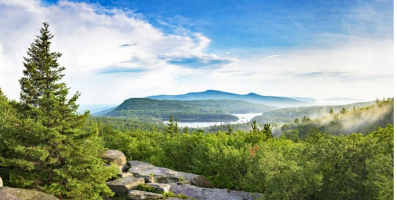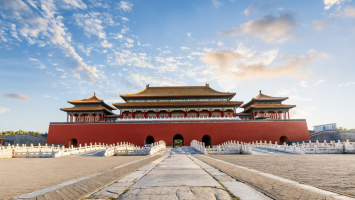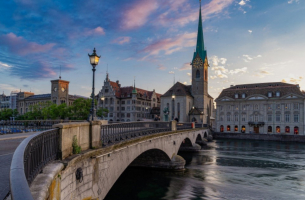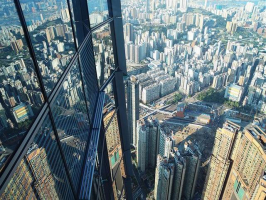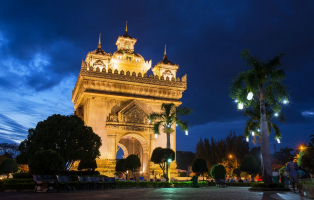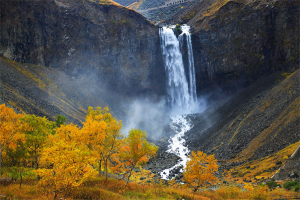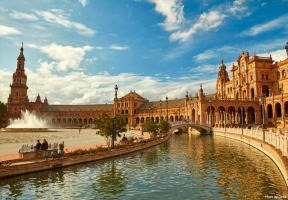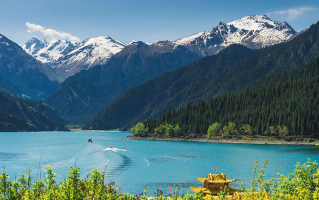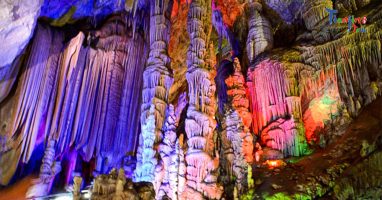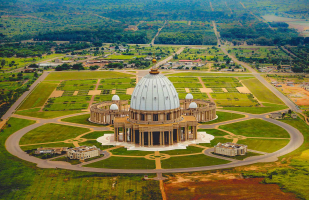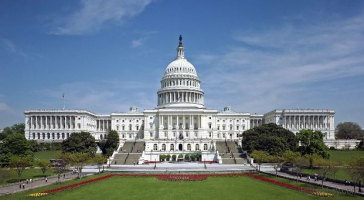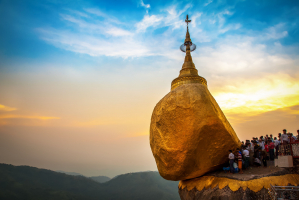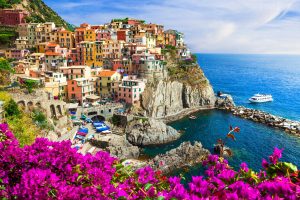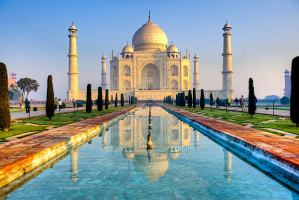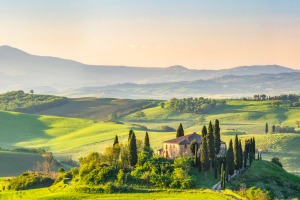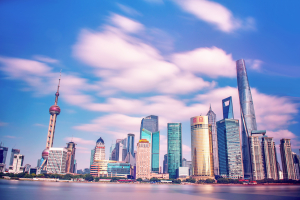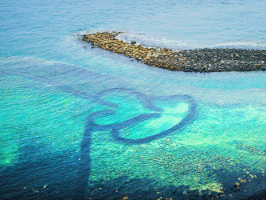Top 15 Most Visited Places In China
China is an exciting vacation destination since it is home to the world's oldest civilization and extensive areas of stunning natural beauty. Its vast expanse ... read more...necessitates a considerable number of appealing destinations, but here are Toplist.info's recommendations for the most significant and most visited sites in China.
-
Fenghuang Ancient Town, aka Phoenix Ancient Town and Feng Huang Gu Cheng in Chinese, is situated on the western boundary of Hunan Province in an area of outstanding natural beauty where mountains, water, and blue skies prevail. Fenghuang Ancient Town has a legend that two of these fabulous birds flew over it and found the Fenghuang Town so beautiful that they hovered there, reluctant to leave.
Upon arrival, visitors will be impressed by its air of mystery, elegance, and primitive simplicity. The scenic spots inside the Fenghuang Old Town remain attractive the whole year, but the best time to visit is July to September when the weather is rather pleasant. It is a world that is dominated by the color green. The green foliage cover mountain slopes, fields, and even the Tuo Jiang River reflects the greenery. The bridges over the water and unique houses built on stilts display a harmony often portrayed in traditional Chinese paintings. It is particularly true when mist pervades the scene in the early morning or after rain.
Fenghuang Ancient Town is a beautiful village, where dozens of alleys paved with flagstones run between the houses, each showing wear caused by the feet of generations of local people who have used them when going about their daily business. For the visitor, these alleys are the way to see the typical high gabled wooden houses built on stilts along the banks of the Tuo Jiang River at close quarters. You can hike up to the Southern Great Wall and enjoy the striking views of the rice terraces. Fenghuang has a bustling feel, and there are plenty of street vendors who sell local foods at great prices (make sure you try the Ginger Candy).
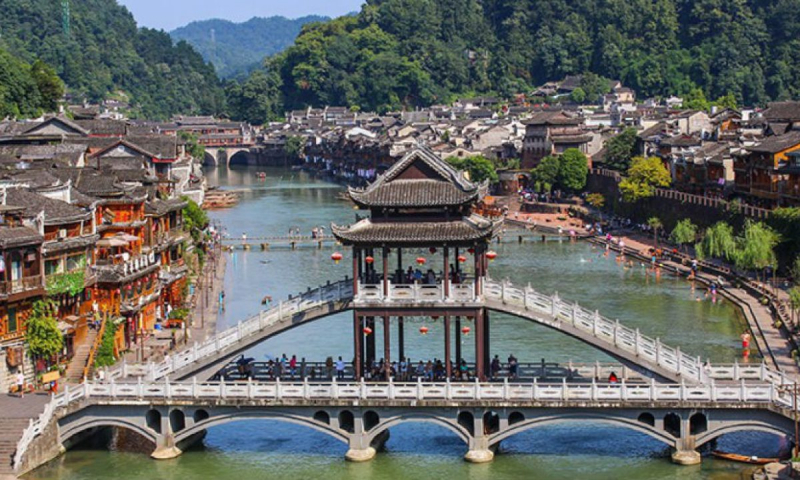
Fenghuang, Hunan province 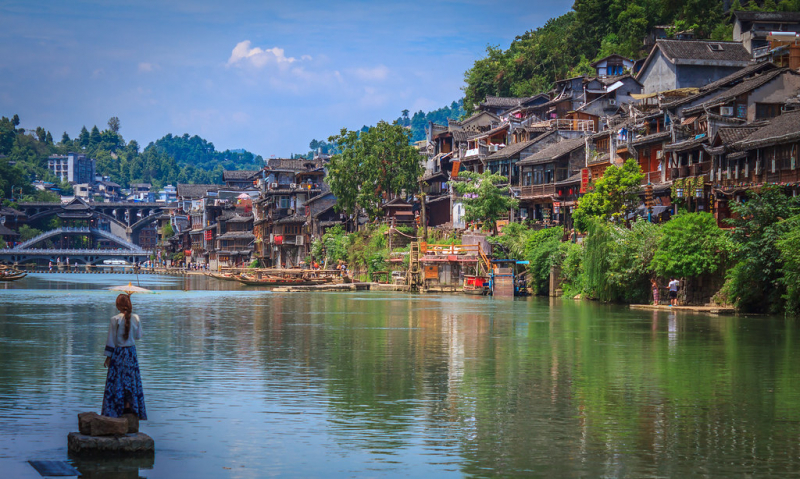
Fenghuang, Hunan province -
Forbidden City is an imperial palace complex at the heart of Beijing, China. Commissioned in 1406 by the Yongle emperor of the Ming dynasty, it was first officially occupied by the court in 1420. It is a UNESCO World Heritage site in 1987 and its distinctive architecture and its current role as the Palace Museum of dynastic art and history.
The architecture of the Forbidden City adheres rigidly to the traditional Chinese geomantic practice of feng shui. The most important buildings within the compound, especially those along the central axis, face south to honor the Sun. The facilities and the ceremonial spaces between them are arranged to convey an impression of the great imperial power. This architecture is borne out to the smallest of details.
Highlights include the Meridian Gate, built-in 1420; the Golden River Bridges, a network of five richly decorated white marble bridges; and the Hall of Preserving Harmony, which functioned as the Emperor's banquet hall. Other places include the Palace of Heavenly Purity, the most extensive gallery in the Inner Court, and the Hall of Military Courage, a permanent residence and private audience hall for the emperors. The impressive 35-meter-high Hall of Supreme Harmony is notable as the country's largest surviving wooden building and its splendidly decorated gilded imperial throne.
Located just a short walk away from The Palace Museum stands the historic Imperial College (Guozijian). Founded in 1287 by Kublai Khan and only closed in 1900, this beautiful structure served as the country's national university and often saw the Emperors of the old visits further their education and knowledge.
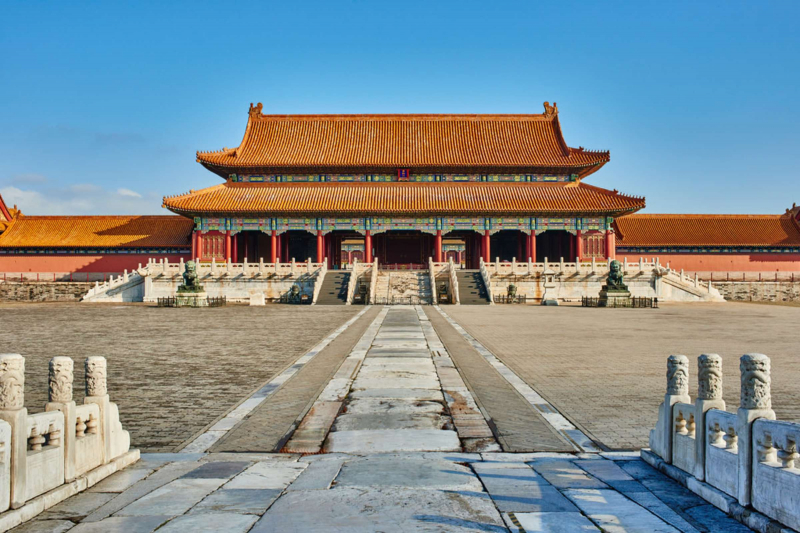
The Forbidden City 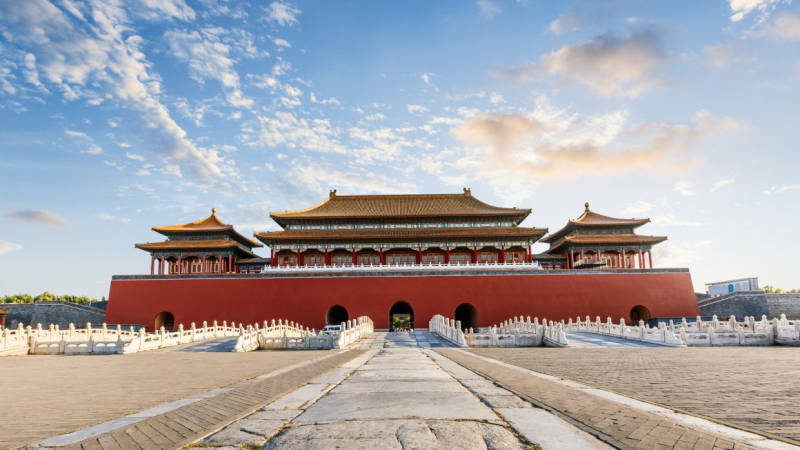
The Forbidden City -
Mausoleum of the First Qin Emperor is a primary Chinese archaeological site near the ancient capital city of Chang’an, Shaanxi, China, now near the modern city of Xi’an. It is the burial place of the first sovereign emperor, Shihuangdi of the Qin dynasty (221–207 BCE), who unified the empire, began the construction of the Great Wall. He prepared for death by constructing a 20-square-mile (50-square-km) funerary compound, the treasures of which started to come to light only some 2,100 years after his death.
In March 1974, a work brigade of farmers drilling a well discovered an underground chamber that archaeologists later found contained an army of some 8,000 life-size terra-cotta soldiers and horses. Along with richly adorned chariots of wood and bronze; iron farm implements; bronze and leather bridles; objects of silk, linen, jade, and such weapons as bows and arrows, spears, and swords, cast from an unusual 13-element alloy.
The compound was declared a UNESCO World Heritage site in 1987. Archaeological excavations on the site continued into the 21st century, and archaeologists anticipated that it would take years to unearth the entire Mausoleum of the First Qin Emperor.
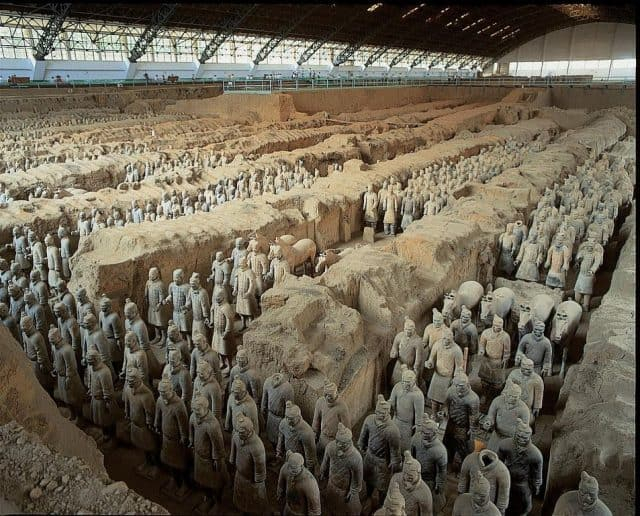
Mausoleum of the First Qin Emperor 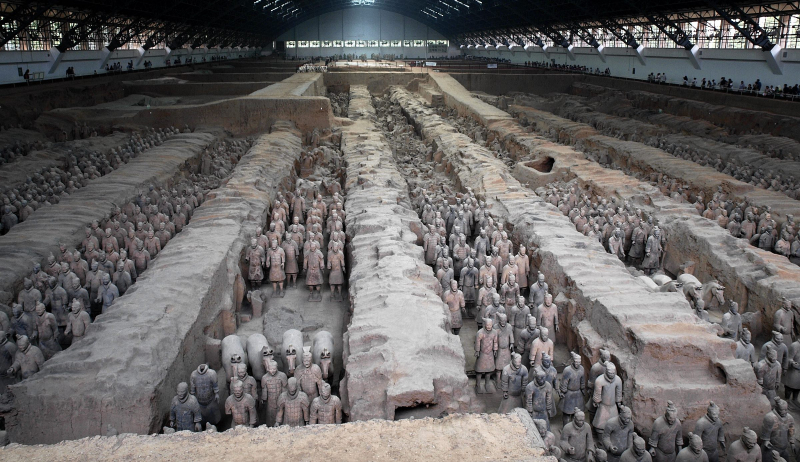
Mausoleum of the First Qin Emperor -
The Great Wall of China's extensive bulwark erected in ancient China was one of the most significant building-construction projects ever undertaken. The Great Wall consists of numerous walls—many of them parallel to each other—built over two millennia across northern China and southern Mongolia. The most extensive and best-preserved wall version dates from the Ming dynasty (1368–1644). It runs for some 5,500 miles (8,850 km) east to west from Mount Hu near Dandong, southeastern Liaoning province, to Jiayu Pass west of Jiuquan, northwestern Gansu province.
Great Wall of China often traces the crest lines of hills and mountains as it snakes across the Chinese countryside, and about one-fourth of its length consists solely of natural barriers such as rivers and mountain ridges. Nearly all of the rest (about 70 percent of the total length) is constructed wall, with the small remaining stretches constituting ditches or moats. Although lengthy sections of the wall are now in ruins or have disappeared completely, it is still one of the more remarkable structures on Earth. The Great Wall was designated a UNESCO World Heritage site in 1987.
Easily one of the most famous landmarks globally, The Great Wall of China winds through a vast array of scenery, taking in deserts, plateaus, mountains, and grasslands. It's not just the beautiful views that make The Great Wall a must-see site in China. The historical connotations and impressive architecture mean it is certainly worth a visit. Although some sections are in ruins or have been removed altogether, this purely reminds you of its history spanning over 2000 years.
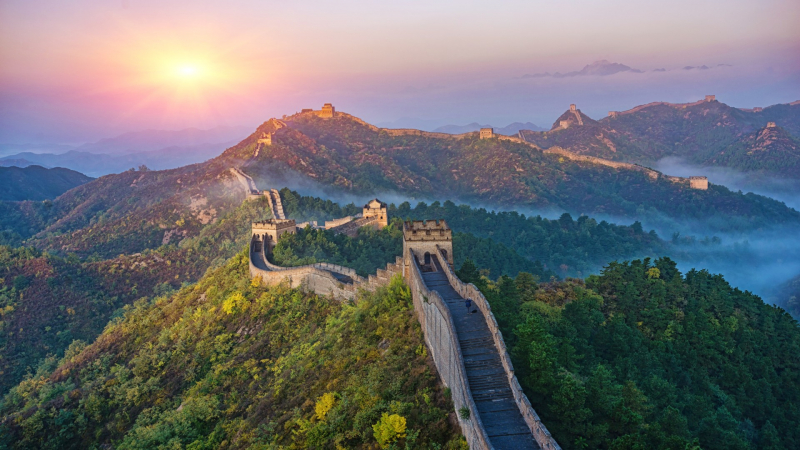
The Great Wall of China 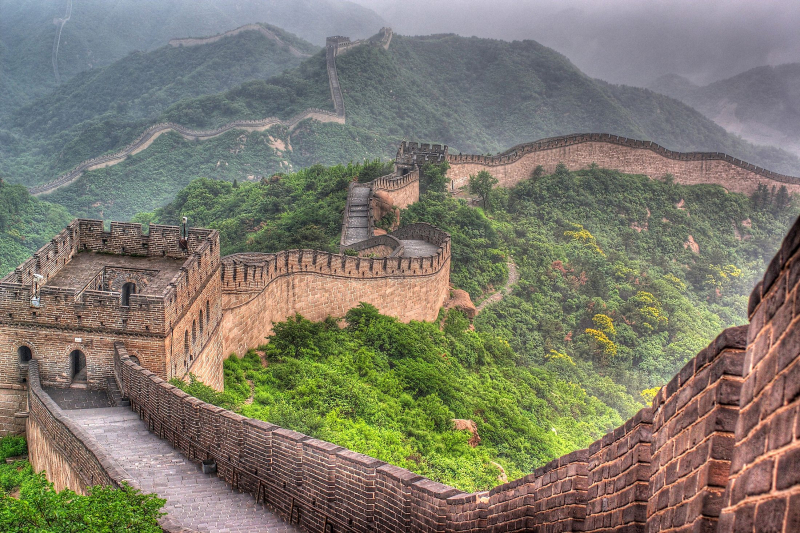
The Great Wall of China -
The Leshan Giant Buddha is a pilgrimage destination for Buddhists and part of the Mount Emei Scenic Area, a UNESCO World Heritage Site. The 233-feet-tall had not endangered the 1,300-year-old monument by rising waters for at least seven decades.
The Leshan Giant Buddha was built between 713 and 803 (during the Tang dynasty). It is carved out of a cliff face of Cretaceous red bed sandstones that lies at the confluence of the Min River and Dadu River in the southern part of Sichuan province in China, near the city of Leshan. The stone sculpture faces Mount Emei, with the rivers flowing below its feet. It is the largest and tallest stone Buddha statue globally, and it is by far the tallest pre-modern statue in the world. It depicts Maitreya, a bodhisattva and a disciple of Siddhārtha Gautama, the founder of Buddhism. The Mount Emei Scenic Area, including Leshan Giant Buddha Scenic Area, has been listed as a UNESCO World Heritage Site since 1996. Although the Chinese government has spent millions in its preservation and restoration, the statue is at risk of erosion by rainwater and air pollution, significantly as the climate emergency worsens.
Being one of the six world cultural heritage sites in the Province of Sichuan, it receives a lot of tourist visits. From 2001-2003, it was ranked the second most popular attraction amongst the local heritage sites with 1.4 to 1.5 million visitors per year. The most convenient way to get to the Giant Buddha from Leshan Town is local bus 13. Upon arrival, it is necessary to purchase a ticket at CNY 90 per person (including Wulong Temple & Mahao Cliff Tomb). The opening hours are 7:30 am-6:30 pm from April until October, and 8:00 am-5:30 pm from October until March. The weekends and holidays are much busier compared to weekdays.
People come from all over the world to worship Maitreya. It has a pedestrian pathway that allows visitors to appreciate the changing view of Buddha’s body through multiple perspectives. It is important to note that the plank pathways are steep and narrow.
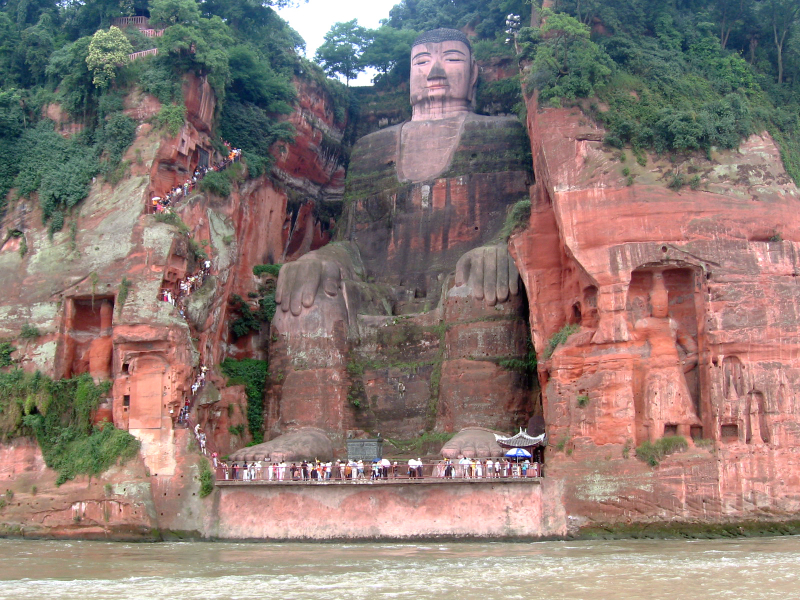
Leshan Giant Buddha 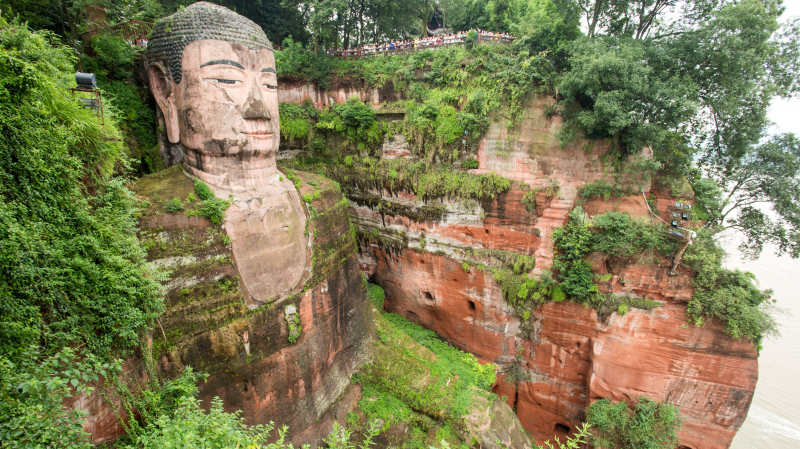
Leshan Giant Buddha -
Wuzhen Water Town, lying in the northern part of Tongxiang City, Zhejiang Province, is a typical ancient town in southern China. It is about 80 kilometers from Hangzhou and Suzhou and 140 kilometers from Shanghai.
As one of the top six ancient towns in the southern region of the Yangtze River, Wuzhen Water Town boasts more than six thousand years of history and has always been a fertile land with great rice, fish, and silk. It preserves the ancient appearance well and oozes the charm of the water town itself. The small town, with houses made of black bricks and gray tiles contrasting sharply with the white walls, appears like a Chinese ink wash drawing. Stone bridges are seen here and there. Small boats with black awnings are floating on the murmuring rivers. Whether wandering along the riverside or strolling in the lanes paved with blue flagstones, you will be deeply impressed by the picturesque scenery and slow lifestyle.
A crisscrossing river divides the whole Wuzhen Water Town into four scenic sections, which are respectively called Dongzha, Nansha, Xizha, and Beizha by local people. Since Nanzha and Beizha are less developed, tourists often visit Dongzha and Xizha. Dongzha maintains the original basic layout while Xizha has been reconstructed to reproduce the ancient appearance of the water town.
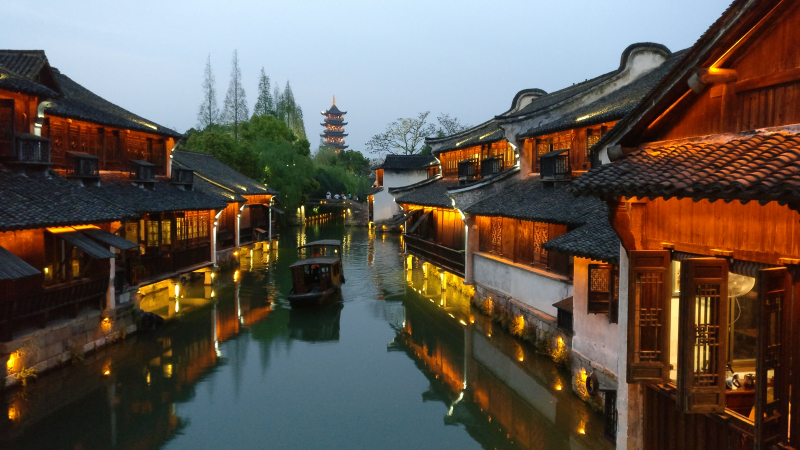
Wuzhen Water Town 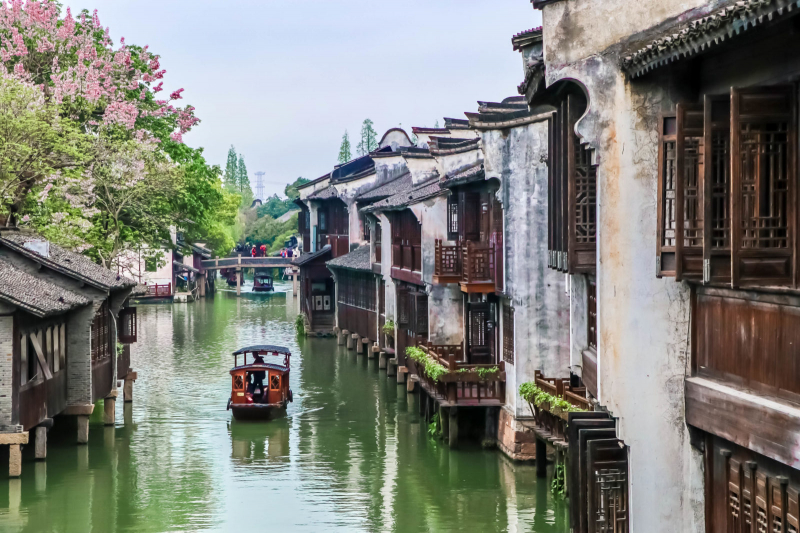
Wuzhen Water Town -
Lijiang Ancient Town, also known as Dayan Old Town, was a former trading town and a stop for traders carrying goods on the Ancient Tea and Horse Road. It became a UNESCO World Heritage Site in 1997.
The architecture of Lijiang Ancient Town is noteworthy for blending elements from several cultures — Naxi, Bai, Yi, Tibetan, and Han. The town also possesses an ancient water supply system of great complexity and ingenuity. Now, Lijiang Old Town has been commercialized, and millions of tourists visit every year, but through different, its character is now even more appealing — it's a travelers' magnet.
Lion Mountain surrounds Lijiang in the west and Elephant and Golden Row Mountains in the north. These mountains in the northwest shelter it from the cold wind. In the southeast, there are fertile fields, which are dozens of kilometers long. Natural favored Lijiang with plentiful sunlight, an east wind, and clear spring water, which flows in three streams and reaches every family. The streets are paved with the local stone slabs, which do not get muddy in the rainy season and are free of dust in the dry season. During the Ming and Qing Dynasties, they built many stone bridges and arches in the city, and orderly roads and lanes extended to four directions from the central square. Residential houses are made of timber; most have a screen wall in front, and some have a quadruple courtyard, in which local people plant many flowers.
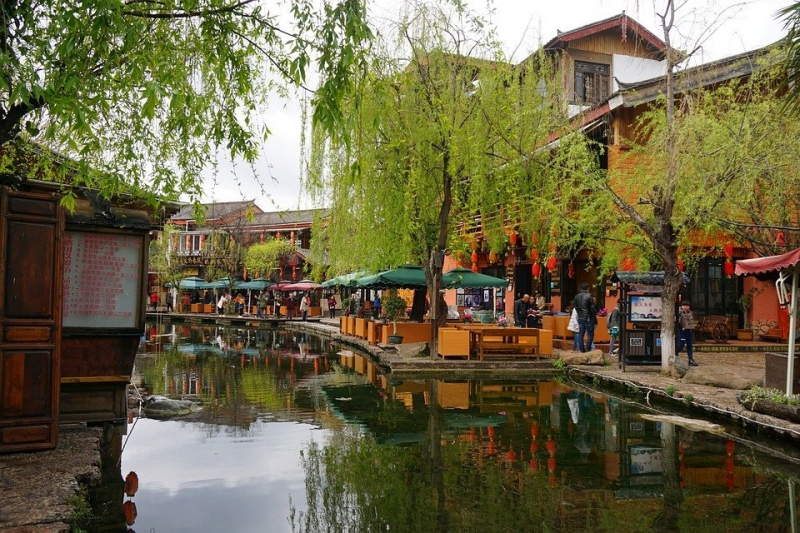
Lijiang Ancient Town 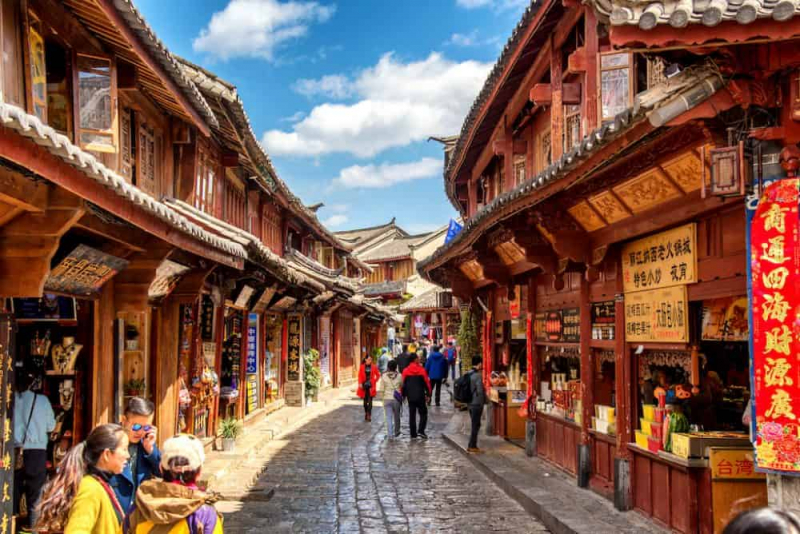
Lijiang Ancient Town -
The Summer Palace in Beijing – first built in 1750, essentially destroyed in the war of 1860, and restored on its original foundations in 1886 – is a Chinese landscape garden design masterpiece. The natural landscape of hills and open water is combined with artificial features such as pavilions, halls, palaces, temples, and bridges to form a harmonious ensemble of outstanding aesthetic value.
Beijing's summer palace integrates numerous traditional halls and pavilions into the Imperial Garden conceived by the Qing emperor Qianlong between 1750 and 1764 as the Garden of Clear Ripples. Using Kunming Lake, the former reservoir of the Yuan dynasty's capital and Longevity Hill as the basic framework, the Summer Palace combined political and administrative, residential, spiritual, and recreational functions within a landscape of lakes and mountains, following the Chinese philosophy of balancing the works of man with nature.
The connecting Residential area comprises three building complexes at the Summer Palace: the Halls of Happiness in Longevity, Jade Ripples, and Yiyun, all built up against the Hill of Longevity, with fine views over the lake. These are linked by roofed corridors connecting the Great Stage to the east and the Long Corridor to the West. The remaining 90% of the garden provides areas for enjoying views and spiritual contemplation and is embellished with garden buildings, including the Tower of the Fragrance of Buddha, the Tower of the Revolving Archive, Wu Fang Pavilion, the Baoyun Bronze Pavilion, and the Hall that Dispels the Clouds. Kunming Lake contains three large islands corresponding to the traditional Chinese symbolic mountain garden element, the southern of which is linked to the East Dike by the Seventeen Arch Bridge. An essential feature is the West Dike, with six bridges in different lengths. Other essential features include temples and monasteries in Han and Tibetan style located on the north side of the Hill of Longevity and the Garden of Harmonious Pleasure to the northeast.
As the culmination of several hundred years of Imperial garden design, the Summer Palace has significantly influenced subsequent oriental garden art and culture.
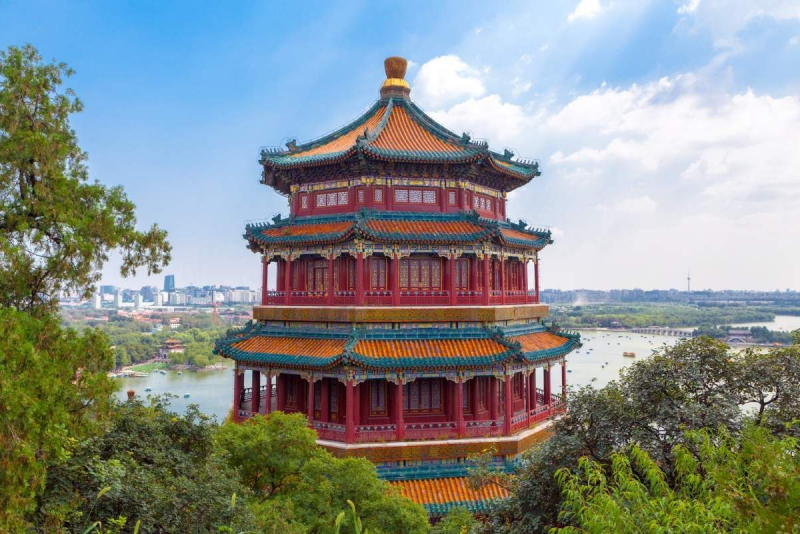
The Summer Palace 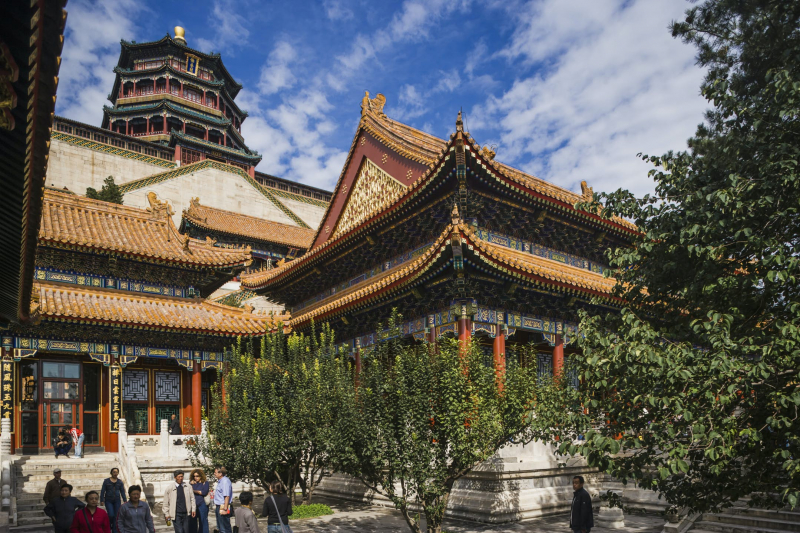
The Summer Palace -
The Guanyin of Nanshan is a 108-meter (354 ft) statue of the bodhisattva Guanyin, sited on the south coast of China's island province Hainan near the Nanshan Temple Sanya. The figure has three aspects: one side faces inland, and the other two face the South China Sea, representing blessing and protection by Guanyin of China and the whole world. One aspect depicts Guanyin cradling a sutra in the left hand and gesturing the Vitaraka Mudra with the right; the second with her palms crossed, holding a string of prayer beads; and the third holding a lotus. As of 2018, this was the twelfth tallest statue in the world.
The Guanyin of Nanshan statue took six years to build and was enshrined on April 24, 2005, with 108 monks from various Buddhist groups in Taiwan, Hong Kong, Macao, and Mainland China pilgrims. The delegation also included monks from the Theravada and Vajrayana traditions.
The island of Hainan has been an important place for Buddhism since it arrived in China. In Buddhism, a Bodhisattva achieved a very high level of knowledge and enlightenment and sought to enlighten all those around him. Avalokitesvara, also known as Guan-Yin, is often represented as female. She had twelve wishes during her life, and one of them was to live near the South China Sea. Today, Hainan is a holy site and is considered the home of Avalokitesvara.
Construction of the Nanshan Temple to mark the 2000th anniversary of the arrival of Buddhism to China. With the rapid urban growth on the island, the Guanyin of Nanshan quickly became popular and received many local and foreign visitors each year.
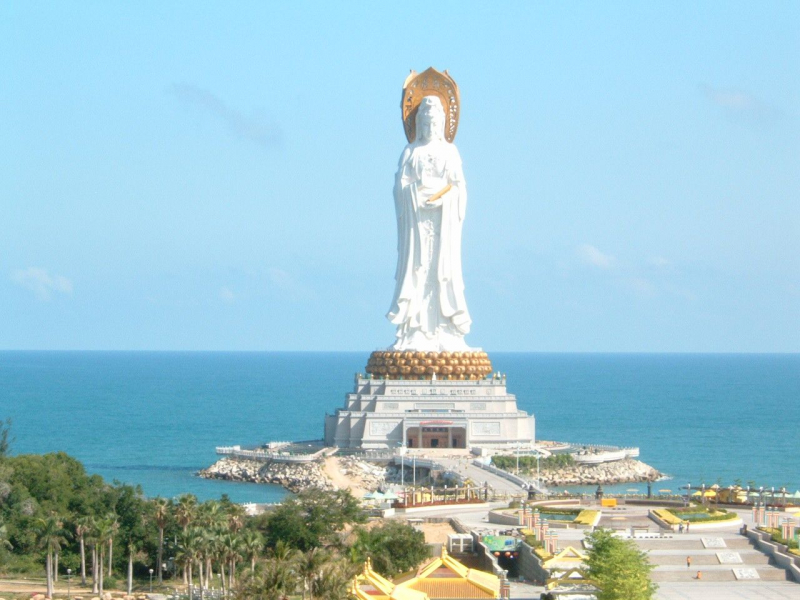
Guanyin Statue 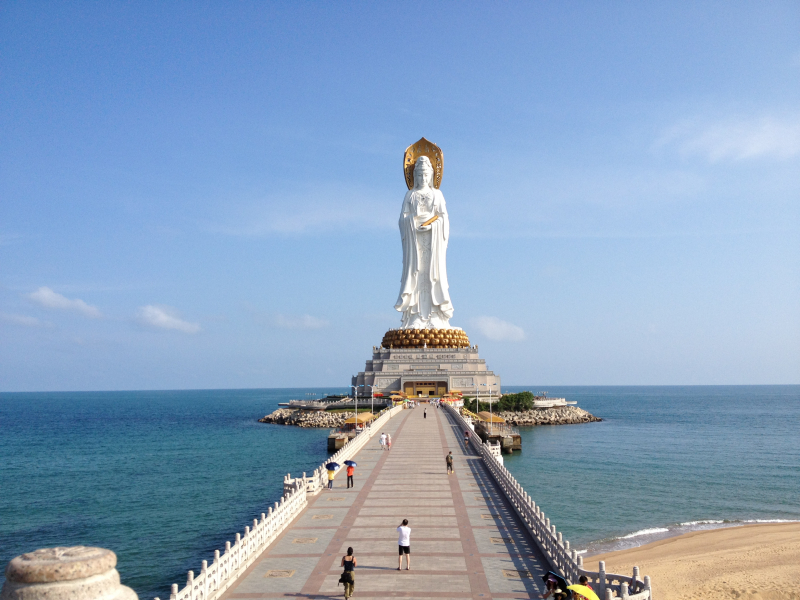
Guanyin Statue -
Yalong Bay is a 7.5-kilometer-long beach in Sanya, Hainan, China. Yalong Bay National Resort is another name for it. As the East Section of Yulin Naval Base, the PLA Navy occupies the eastern section of the harbor.
It is one of China's most gorgeous beaches. It is located on Hainan's shore and provides swimming, snorkeling, jet-skiing, and diving. Crystal-clear sea, white sand beaches, and China's top beach resorts. The waters are so clean that visibility may reach about 8 meters deep, making it ideal for scuba diving and snorkeling on Sanya Hainan Island.
Yalong Bay is the most significant area to relax on the beach and enjoy the crystal-clear sea, sandy beach, and resort facilities. If you work in China and want to get away from the hustle and bustle of the city, Yalong Bay is the place to be. Each resort in Yalong Bay has its private beach area with umbrellas and beach chairs for resort guests exclusively. Because it is a beach resort, you don't witness much local life; instead, you see options and visitors from all over the world. Sometimes you don't feel like you're in Sanya, but rather in Hawaii, Florida, or any other beach resort globally.
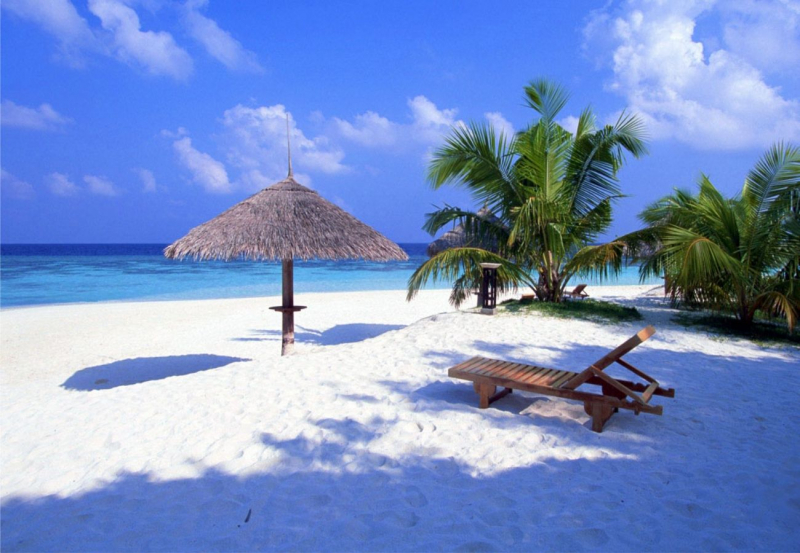
Yalong Bay 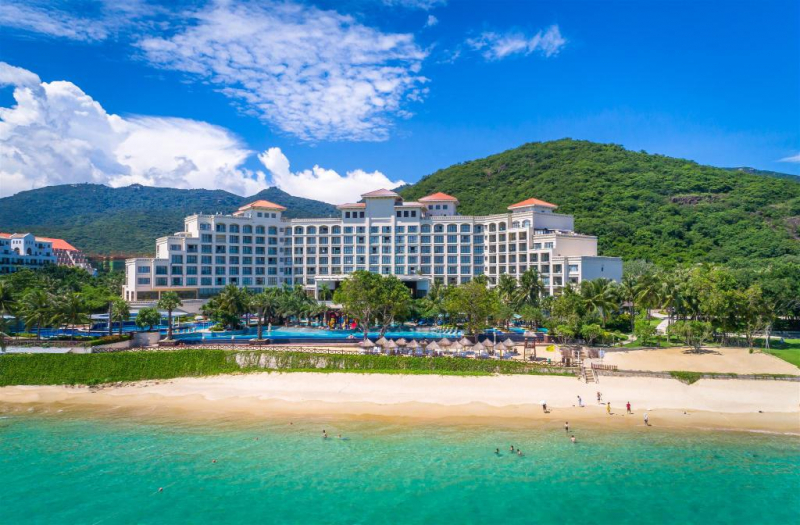
Yalong Bay -
The Yellow Mountains is one of China's most famous and beautiful mountainous areas. It was listed as a World Heritage Site by UNESCO in 1990. Its spectacular natural scenery includes oddly-shaped pines and rocks and mystical seas of cloud.
The Yellow Mountains are not so-called because the mountains are yellow, but because the area was renamed after the legendary Yellow Emperor (Huang Di) in 747 AD. After that, Huangshan began its ascent to fame. Many Buddhist temples have been built there and, more recently, it has become a significant tourist attraction because of its scenic qualities. It is said that the Yellow Mountains is the place where the Yellow Emperor, the mythical ancestor of the Chinese, lived, refined precious medicines, and became a supernatural being.
The Yellow Mountains range is known for its hot springs, dense pine forests, and mystical aura. It sits majestically with a misty sea of clouds at its feet, but each season gives the mountains a different flavor. In springtime, it is scattered with pretty pink blossoms, bright flowers that illuminate the valleys and fill the air with their heady scent.
The mountains are densely green in the summer, and bubbling streams lap against the rock faces. The turning maples paint the mountains red and violet in autumn before winter turns everything icy white and tranquil. The area is rich with flora and renowned for monkeys, deer, goats, and rare birds. Many ancient texts, paintings, and poems have celebrated the Yellow Mountains range, and this sense of spiritual reverence remains.
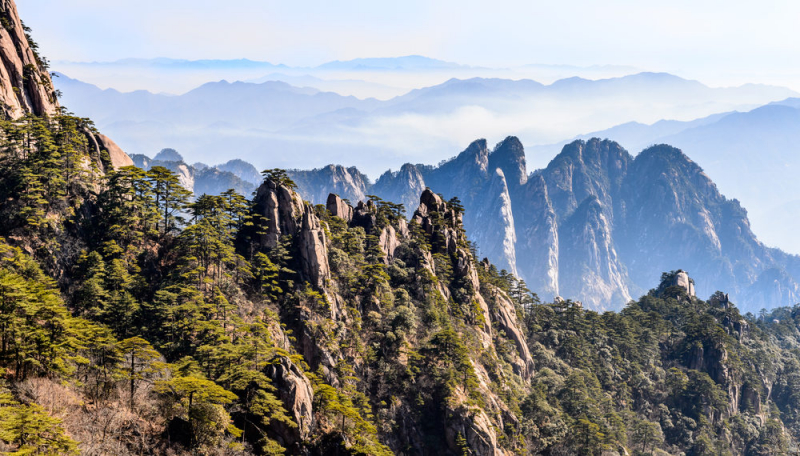
The Yellow Mountains (Huangshan) 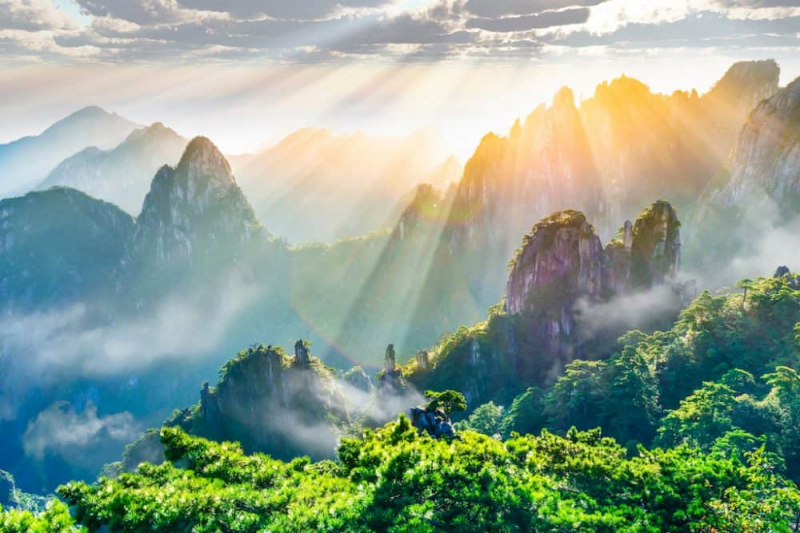
The Yellow Mountains (Huangshan) -
Yuanyang Rice Terraces has been a masterpiece of the ingenuity of the Hani people for generations. Southern Ailao Mountain, with this typical tiered landscape, is famed for its unique frontier scenery.
The Hani people's ancestors came to this steep mountain area 2,500 years ago. In their struggle against the rugged terrain, they successfully established the terraces to grow rice to make a living. The creativity of the Hani people turned this mountain area into one of artistic beauty. In recognition, the Ming Dynasty (1368-1644) emperor granted the title of 'Skillful Sculptor' to the Hani people, and it passed down their excellent reputation from generation to generation. At present, known as 'land sculpture,' the Yuanyang Rice Terraces fields have been officially acknowledged by UNESCO as a World Cultural and Natural Heritage site.
Yuanyang Rice Terraces fields are magnificent and on a large scale. They extend to many towns along the south bank of the Red River, such as Yuanyang, Lüchun, and Jinping, among others. With more than 113 square kilometers, the terrace in Yuanyang County is regarded as the core area of Hani terraces. The county is mountainous, and the terraces built on the hillsides have a slope varying from 15 to 75 degrees. The Yuanyang rice terraces form three major scenic areas: Duoyishu scenic area, Bada scenic area, and Laohuzui (the Tiger Mouth) scenic area. So many terraces set among vast forests, topped by an ocean of clouds, create a magical, magnificent view. The rolling landscape is just as attractive as the rice terraces themselves, so you'll never run out of gorgeous pictures.
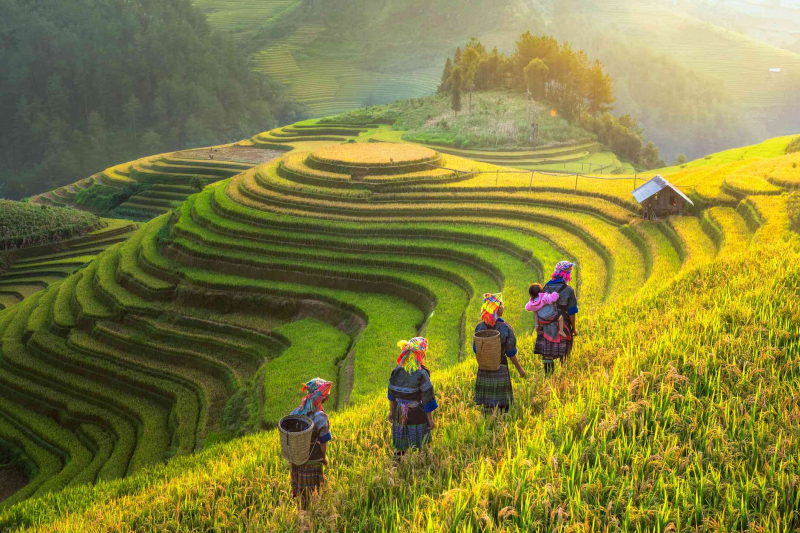
Yuanyang Rice Terraces 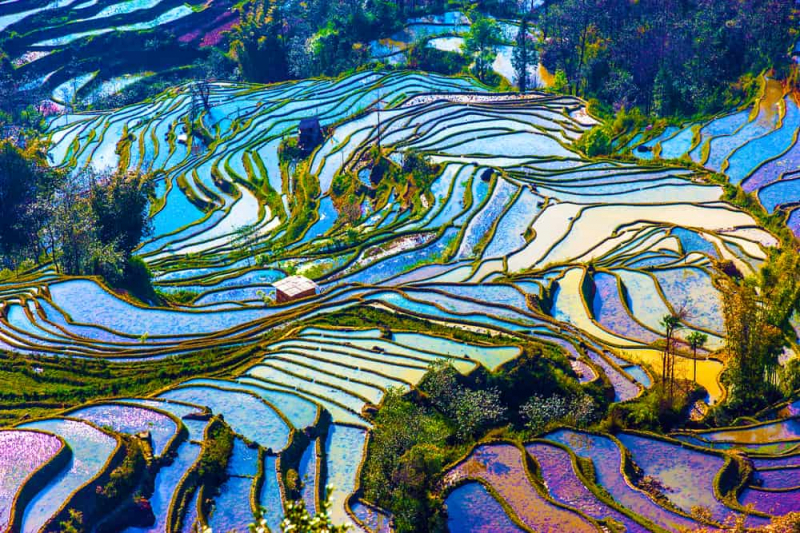
Yuanyang Rice Terraces -
The ancient village of Hongcun, about 70 km from Huangshan, is considered the most picturesque village in the Huizhou region. With lush green hills and lotus-covered ponds and lakes, Hongcun is a beautiful place, enchanting thousands of visitors every year.
UNESCO declared Hongcun World Heritage Site in 2000, a title that the village deserves. The unique quality and exceptional value of traditional Hui architecture make Hongcun one of the most important and well-preserved cultural heritage sites for Chinese vernacular architecture. Not to mention the magnificent landscape and scenery of the region, which is one of the most famous and appreciated in China.
Established in 1131 during the Southern Song Dynasty, the village’s history is over 900 years old. The town was designed to resemble the shape of a buffalo. Leingang Hill at the back of the city is supposed to be the head, the buildings of the village form the body, the Moon Pond in the middle of the town is the stomach, the many streams that run within the houses are the entrails, and four bridges across the lake are legs.
You can visit many Ming and Qing buildings inside the village. Some of the most majestic ones, usual residences for wealthy families, are now maintained as museums where visitors can tour their interiors. The most picturesque, renowned feature of Hongcun is the Moon Pond, located in the center of the village. It shaped like a crescent moon to supply the villagers with water. The blue sky and jagged edges of the Hui houses reflect off the water, creating stunning reflections in the ripples and an enchanting beauty peculiar in the ancient setting of a vernacular place, designed for utility rather than elegance.
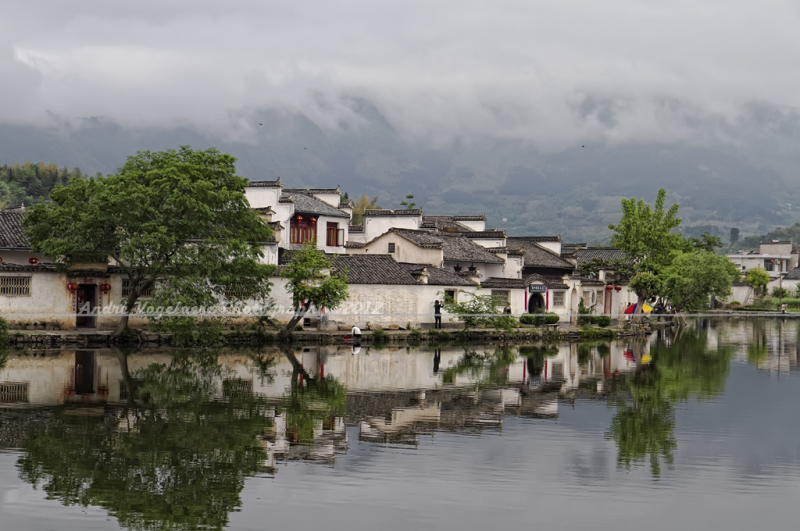
Hongcun Ancient Village 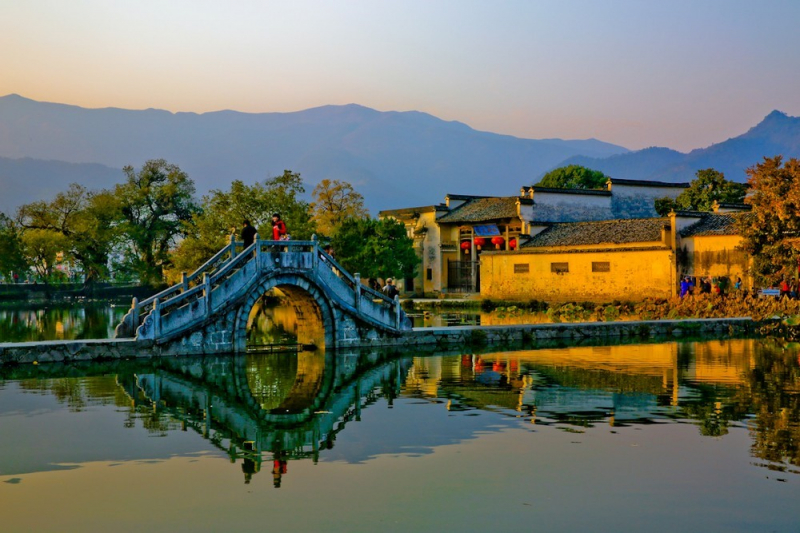
Hongcun Ancient Village -
In Chinese, Echoing-Sand Mountain, also known as Mingsha Shan, is located five kilometers from Dunhuang. The mountain is like a golden dragon weaving its way across the horizon from afar. As you go closer, you notice that the sand is a variety of hues, ranging from red to yellow, green, black, and white. When there is a strong wind, the fast-moving sand roars, but when there is only a faint breeze, the sand emits soothing, dulcet sounds like music. When you're falling down the slope, it's the same thing. The sand beneath your boots first murmurs, but the more you slide, the louder the sound becomes until it reaches a crescendo like thunder or a drum beat. Some people say the sand is singing, while others, it is like an echo, and this is how the mountain gets its name.
You might be wondering why the sand creates such a variety of noises. According to mythology, a commander and his army came here to battle in a war against their foes in ancient times. A massive gust of wind covered all the soldiers in the sand, building the sand mountain, as they were engaged in violent combat. At the height of the conflict, the men continued to fight beneath the sand. As a result, the sound you're hearing is supposed to be the troops' roar. The actual reason is the friction and static caused when the wind changes the sand or you fall down the hillside.
Echoing-Sand Mountain surrounds crescent Lake. The lake's water is so clear and delicious that it resembles an emerald embedded in the sand. According to historical documents, the lake has existed for hundreds of years without being buried by sand; it is a geological miracle. There is also a legend around the lake. During the Western Han Dynasty, Li Guang and a troop of men seized a powerful and speedy horse from Dawan, a western Chinese kingdom. The soldiers felt too thirsty to continue their march after passing the Echoing-Sand Mountain on their way back. General Li drew his sword and thrust it into the side of the mountain, causing water to spring forth and so formed the lake.
Echoing-Sand Mountain has been designated as an important national scenic area. It may be climbed on foot or, if preferred, on the back of a camel. There is also the option of having a sand bath treatment. Your stay is complete when you take in the magnificent scenery of golden beaches, a massive mountain, a quiet lake, and a stunning sunset.
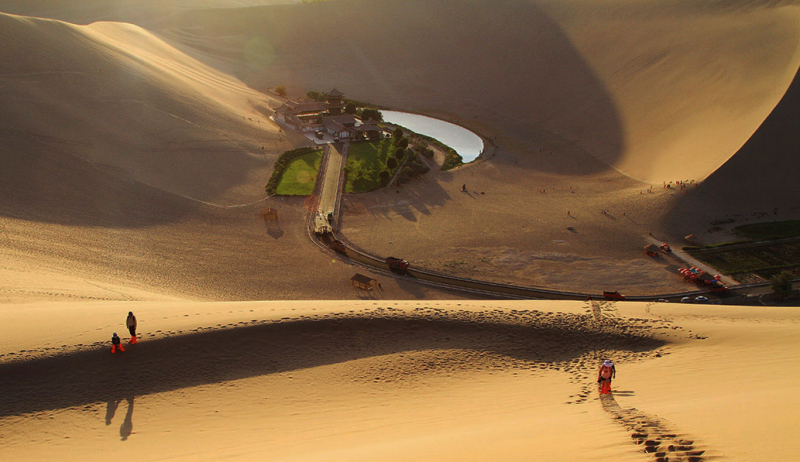
Echoing Sand Mountain and Crescent Lake 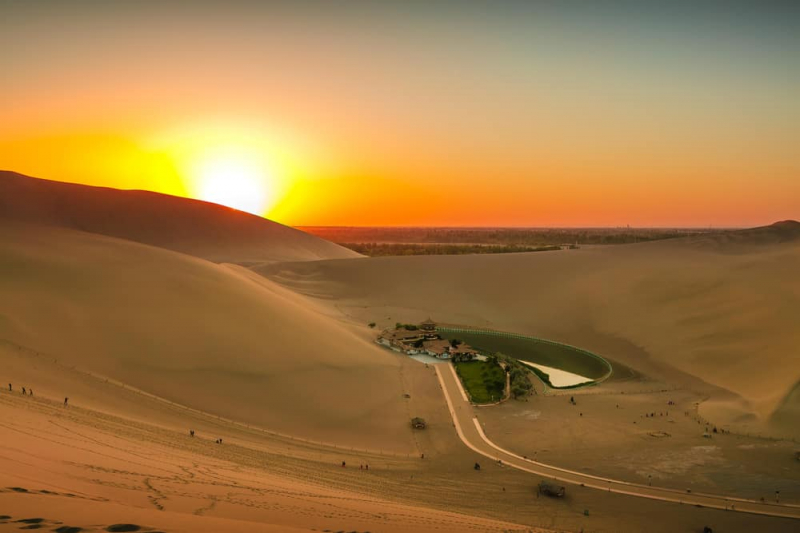
Echoing Sand Mountain and Crescent Lake -
The Temple of Heaven in the southern part of Beijing is China's largest existing complex of ancient sacrificial buildings. Occupying an area of 273 hectares, it is three times the area of the Forbidden City. It was built in 1420 for emperors to worship Heaven. Surrounded by lush vegetation, these lovely old temples and shrines are set out in two sections – one rectangular; the other semi-circular – which together symbolize Heaven and Earth. The principal buildings include the Altar of Prayer for Good Harvests, Imperial Vault of Heaven, and Circular Mound Altar.
The Altar of Prayer for Good Harvest, 38 meters in height and 30 meters in diameter, stands on a round foundation built with three levels of marble stones. This towering triple-eave hall is under a three-story, cone-shaped glaze-tile roof in blue color crowned with a gilded knob. A circular wall of polished bricks known as the Echo Wall encloses the Imperial Vault of Heaven. The Circular Mount Altar, south to the Imperial Vault of Heaven, is where the Emperor prayed to Heaven. A round stone called the Center of Heaven Stone lies at the center that echoes when a visitor speaks loud when standing on the rock.
It was here that, on the day of the winter solstice, the Emperor would ascend the Heavenly Altar in a solemn ceremony to pray for a good harvest and offer sacrifices in the brightly decorated Hall of Prayer for Good Harvests (Qinian Dian). Be sure also to visit the temple's Echo Wall, which echoes to even the quietest of voices, an effect exaggerated by three unusual echoing stones.
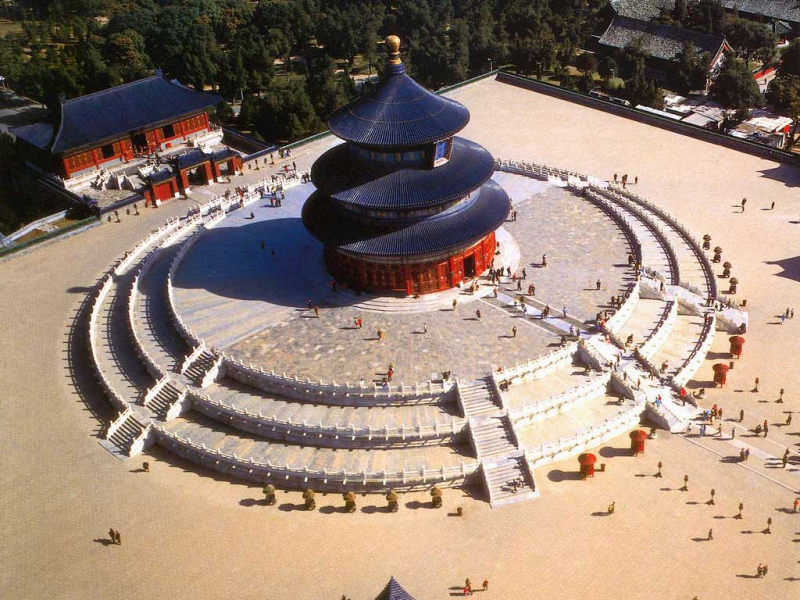
The Temple of Heaven 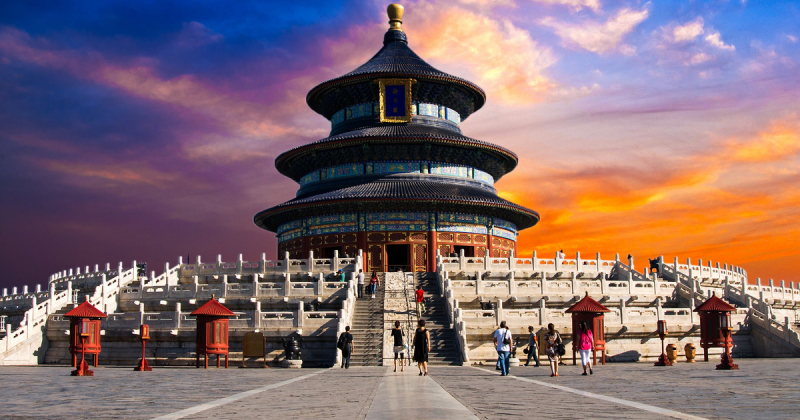
The Temple of Heaven

















